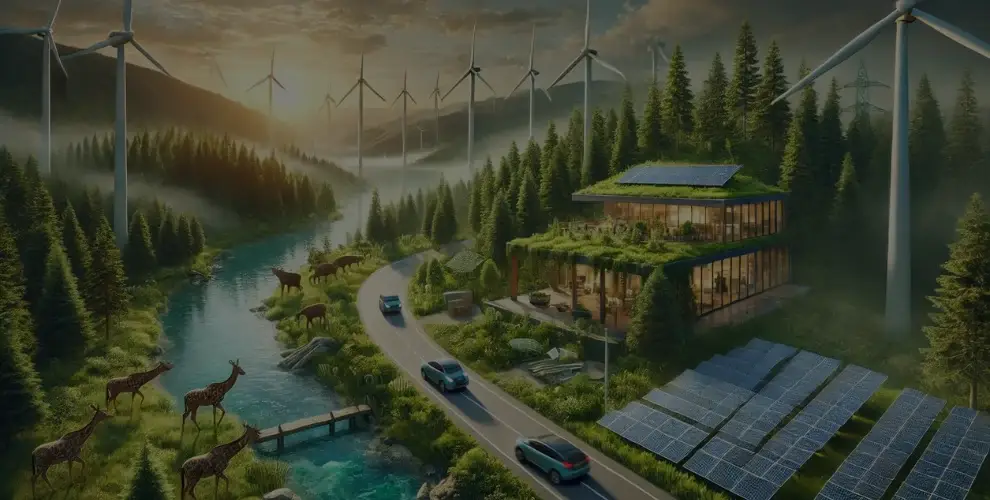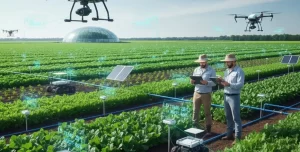
How Sustainable Technology Helps Protect Our Planet
Table of Contents
Introduction
Welcome to WikiGlitz!
We have brought you this amazing blog on how sustainable technology helps protect our planet.
In a world facing climate change and environmental degradation, sustainable technology has emerged as a solution to mitigate the negative impacts of human activities.
By promoting sustainable development, reducing carbon emissions, and conserving resources, these technologies aim to create a more harmonious relationship between human innovation and the natural environment.
Key Takeaways:
- Sustainable technology reduces environmental impacts by utilizing renewable resources and minimizing waste.
- Innovations in technology support sustainable development goals and long-term environmental protection.
- Green technology solutions offer practical methods for fighting climate change and reducing carbon emissions.
How Sustainable Technology Helps Protect the Planet
Sustainable technology is rapidly becoming one of the most important tools in our fight to protect the planet. But how exactly does it help?
- Reducing Waste and Pollution: One of the key benefits of sustainable technology is its ability to reduce waste. Through innovations like waste-to-energy systems, we can convert waste products into energy, significantly decreasing the volume of waste sent to landfills.
- Minimizing Resource Depletion: Sustainable technology focuses on using renewable resources like solar and wind power, which are naturally replenished and reduce the need for finite resources like coal and oil.
- Combatting Climate Change: By lowering greenhouse gas emissions through renewable energy, sustainable technology plays a direct role in fighting climate change. Technologies like electric vehicles (EVs) and carbon capture systems help reduce harmful emissions that contribute to global warming.
Reducing the Environmental Impact of Technology
Technological advancements have often come at the cost of environmental health. However, sustainable technology offers a way to reduce this negative impact.
- Energy Efficiency: Energy-efficient technologies, such as LED lighting and smart thermostats, consume far less energy than traditional counterparts, leading to lower greenhouse gas emissions.
- Sustainable Manufacturing: Innovations in manufacturing techniques, such as 3D printing, use fewer raw materials and produce less waste, reducing the environmental footprint of the production process.
- Cleaner Production Processes: Many industries are adopting sustainable practices such as using less water in production and reducing toxic chemical emissions, which greatly decreases their overall environmental impact.
Promoting Sustainable Development with Technology
Sustainable technology is key to achieving long-term development goals that balance economic growth with environmental conservation.
- Renewable Energy Integration: Sustainable development emphasizes the use of renewable energy sources like solar and wind to power homes, businesses, and cities. This helps reduce reliance on fossil fuels and promotes a clean, sustainable future.
- Green Infrastructure: Sustainable development also includes creating infrastructure that is environmentally friendly, such as eco-friendly buildings and transportation systems that emit fewer pollutants and conserve resources.
- Technological Innovations: By encouraging technological innovations that reduce energy use, waste, and emissions, sustainable development aims to create a future where technological growth does not come at the planet’s expense.
Using Renewable Resources to Protect the Environment
Using renewable resources is one of the most critical ways we can protect the environment.
- Solar Energy: Solar panels are a prime example of renewable resources. By capturing sunlight and converting it into electricity, solar technology reduces reliance on polluting fossil fuels.
- Wind Power: Wind turbines generate electricity from wind energy, offering a clean and renewable alternative to coal-powered electricity.
- Hydropower: Harnessing the energy of flowing water, hydropower plants provide a reliable source of renewable energy while minimizing environmental impact.
These renewable resources help ensure that energy production does not come at the expense of the planet.
How Biodegradable Materials Contribute to Sustainability
Biodegradable materials have become a major focus in sustainable technology, helping to reduce the environmental impact of waste.
- Reduced Plastic Pollution: Traditional plastics take hundreds of years to decompose. Biodegradable plastics, on the other hand, break down much faster, reducing the accumulation of plastic in landfills and oceans.
- Composting: Biodegradable materials such as food waste can be composted, turning waste into valuable organic fertilizer for agriculture. This reduces landfill waste while promoting sustainable farming practices.
- Lower Carbon Footprint: Since biodegradable materials decompose naturally, they release fewer greenhouse gases than non-biodegradable materials during their breakdown process.
By utilizing biodegradable materials, we can greatly reduce the environmental harm caused by waste.
Preventing Negative Environmental Impacts with Technology
Sustainable technology can play a key role in preventing negative environmental impacts caused by human activities.
- Carbon Capture and Storage (CCS): This technology captures carbon emissions from factories and power plants before they enter the atmosphere, storing them underground to prevent them from contributing to global warming.
- Smart Irrigation Systems: Efficient water use is another area where technology can help. Smart irrigation systems ensure that crops receive only the amount of water they need, preventing water wastage and conserving this valuable resource.
- Waste Management Technologies: Technologies like recycling systems and waste-to-energy facilities reduce the amount of waste that ends up in landfills, minimizing the impact of waste disposal on the environment.
Efficient Technologies for Sustainable Energy Use
Efficiency is at the heart of many sustainable technologies, helping to reduce resource consumption and environmental impact.
- Energy-Efficient Appliances: Appliances such as refrigerators, washing machines, and air conditioners have become much more energy-efficient, helping households and businesses reduce their energy consumption.
- Electric Vehicles (EVs): EVs offer an energy-efficient alternative to traditional gasoline-powered vehicles. They produce zero tailpipe emissions and can be powered by renewable energy sources, drastically reducing their environmental impact.
- Smart Grids: Smart grids improve the efficiency of electricity distribution by ensuring that energy is delivered where it is needed most, reducing waste and lowering overall energy use.
These technologies help reduce resource use while maintaining the quality of life.
Renewable Energy Sources for Sustainable Development
Renewable energy sources are essential for achieving long-term sustainable development.
- Solar Power: Solar energy is a key component of sustainable development. Solar panels can be installed on homes, businesses, and even vehicles, providing a clean, renewable source of energy.
- Wind Energy: Wind farms are being developed worldwide to provide communities with renewable power. By harnessing the natural power of wind, we can reduce our reliance on non-renewable energy sources like coal and oil.
- Geothermal Energy: This lesser-known renewable energy source uses the Earth’s natural heat to generate electricity. It’s a highly sustainable option that can provide energy with little environmental impact.
These renewable energy sources are crucial for creating a sustainable future.
Sustainable Technology Innovations for Environmental Protection
New sustainable technology innovations are constantly being developed to protect the environment and address pressing global challenges.
- Vertical Farming: This technology allows for crops to be grown in vertically stacked layers, reducing the land required for agriculture and conserving water and nutrients.
- Green Building Technologies: Innovations in building materials and design are helping create buildings that use less energy and produce fewer emissions.
- Carbon-Neutral Cement: Cement production is a significant source of carbon emissions. Carbon-neutral cement, which absorbs CO2 from the atmosphere during the curing process, is a groundbreaking innovation aimed at reducing this impact.
These innovations are paving the way for a more sustainable and environmentally friendly world.
How Technology Reduces Carbon Emissions
One of the most important contributions of sustainable technology is its ability to reduce carbon emissions, a major driver of climate change.
- Electric Vehicles (EVs): EVs emit no tailpipe emissions, drastically reducing the carbon footprint of transportation.
- Carbon Capture Technologies: Carbon capture systems are designed to trap carbon dioxide before it is released into the atmosphere, reducing the overall level of emissions.
- Renewable Energy: Solar, wind, and hydropower produce electricity without burning fossil fuels, offering clean alternatives that produce no direct emissions.
These technologies are critical in the global effort to reduce carbon emissions and combat climate change.
Green Technology Solutions for Planet Conservation
Green technology solutions offer practical methods for conserving the planet and protecting natural resources.
- Energy-Efficient Homes: Green technologies like smart thermostats and LED lighting help homeowners reduce their energy use and save on utility bills while conserving resources.
- Sustainable Agriculture: Precision farming technologies, such as drones and sensors, help farmers monitor crop health and apply water and nutrients more efficiently, conserving resources and reducing waste.
- Conservation Drones: Drones are being used in conservation efforts to monitor endangered species and protect biodiversity in remote areas.
These solutions provide scalable ways to address environmental challenges and ensure long-term sustainability.
Sustainable Development Goals Through Technology
Technology is an essential tool in achieving the United Nations’ Sustainable Development Goals (SDGs), particularly those related to environmental conservation.
- Affordable and Clean Energy (SDG 7): Technologies like solar panels and wind turbines are making clean energy more accessible and affordable, contributing to SDG 7.
- Sustainable Cities and Communities (SDG 11): Smart cities that incorporate green infrastructure and energy-efficient buildings are helping create more sustainable urban environments.
- Climate Action (SDG 13): Technologies that reduce emissions, conserve resources, and promote renewable energy are at the forefront of climate action, helping to combat the effects of global warming.
These technologies are helping create a more sustainable and equitable world.
Using Technology to Fight Climate Change
Technology is one of the most powerful tools we have to fight climate change.
- Electric Vehicles (EVs): EVs significantly reduce the emissions associated with transportation, which is one of the largest sources of greenhouse gases.
- Renewable Energy: Technologies that harness renewable energy, such as solar and wind power, reduce reliance on fossil fuels, lowering emissions and mitigating climate change.
- Carbon Capture and Storage (CCS): CCS technology captures carbon emissions from power plants and factories, preventing them from entering the atmosphere and contributing to climate change.
By using these technologies, we can take meaningful action in the fight against climate change.
Conclusion
Thank you for reading this blog on how sustainable technology helps protect our planet, brought to you by WikiGlitz.
As we have explored, sustainable technology plays a critical role in reducing the environmental impact of human activities, promoting renewable energy, and driving innovations that contribute to sustainable development.
By embracing technologies that reduce carbon emissions, improve energy efficiency, and utilize renewable resources, we can protect the planet while supporting economic growth.
Sustainable technology is not only an investment in the environment but also in the future of humanity.
Follow WikiGlitz for more insights on how technology is shaping a sustainable future.
FAQs:
1. How does sustainable technology reduce carbon emissions?
Sustainable technology reduces carbon emissions by utilizing renewable energy sources, like solar and wind, and promoting energy-efficient solutions like electric vehicles and smart grids.
2. What role does technology play in sustainable development?
Technology helps achieve sustainable development by providing innovative solutions such as renewable energy, green building materials, and smart cities, all aimed at reducing environmental harm.
3. How do biodegradable materials contribute to sustainability?
Biodegradable materials break down naturally, reducing landfill waste and minimizing pollution, making them a more sustainable option than traditional non-degradable plastics.
Want to keep up with our blog?
Our most valuable tips right inside your inbox, once per month.
Error: Contact form not found.
WikiGlitz Team
Welcome to WikiGlitz, your ultimate destination for tech insights and innovation. Our expert team is dedicated to delivering free resources and professional advice on various technology topics, including Artificial Intelligence, Cyber Security, Cloud Computing, and more. We strive to empower our readers with up-to-date information and practical guidance, ensuring you stay ahead in the rapidly evolving tech landscape. At WikiGlitz, we are passionate about making complex technology accessible to everyone. Our team of seasoned experts curates content that is both informative and engaging, helping you understand and leverage the latest tech trends. Whether you're a tech enthusiast or a professional, WikiGlitz is your go-to source for reliable, expert-driven content. Join us on this journey to explore and embrace the future of technology.





